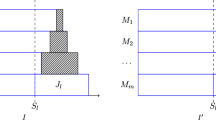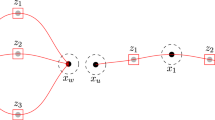Abstract
We consider a system with two heterogeneous traffic classes. The users from both classes randomly generate service requests, one class having light-tailed properties, the other one exhibiting heavy-tailed characteristics. The heterogeneity in service requirements reflects the extreme variability in flow sizes observed in the Internet, with a vast majority of small transfers (“mice”) and a limited number of exceptionally large flows (“elephants”). The active traffic flows share the available bandwidth in a Processor-Sharing (ps) fashion. Theps discipline has emerged as a natural paradigm for modeling the flow-level performance of band-width-sharing protocols liketcp. The number of simultaneously active traffic flows is limited by a threshold on the maximum system occupancy. We obtain the exact asymptotics of the transfer delays incurred by the users from the light-tailed class. The results show that the threshold mechanism significantly reduces the detrimental performance impact of the heavy-tailed class.
Résumé
On considère un système doté de deux classes de trafic hétérogènes. Les utilisateurs de ces deux classes engendrent aléatoirement des demandes de service, l’une des classes ayant une loi à décroissance rapide, l’autre une loi à décroissance lente. Cette hétérogénéité dans les demandes reflète les grandes variations observées dans le trafic de l’internet: une grosse majorité de petits transferts (les « souris ») et un petit nombre de très gros transferts (les « éléphants »). Les flux de trafic se partagent la capacité disponible suivant le modèle de partage de processeur (ps ou Processor Sharing) qui a déjà été utilisé pour modéliser le comportement de protocoles commetcp. Le nombre de flux de trafic simultanés est limité par un seuil d’occupation maximale du système. On obtient la limite exacte des retards de transfert auxquels s’exposent les utilisateurs de la classe « souris ». Les résultats montrent que le mécanisme de seuil diminue sensiblement l’impact négatif de la classe « éléphant ».
Similar content being viewed by others
References
Altman (E.),Avrachenkov (K.),Barakat (C.),Núñez-Queija (R.), State-dependent M/G/1 type queueing analysis for congestion control in data networks, In:Proc. Infocom 2001 Conference, Anchorage AK, USA, 1350–1359.
Ben Fredj (S.),Bonald (T.),Proutière (A.),Régnié (G.),Roberts (J.W.), Statistical bandwidth sharing: a study of congestion at the flow level.In: Proc. Sigcomm 2001, p. 111–122.
Bonald (T.),Massoulié (L.), Impact of fairness on Internet performance, In:Proc. acm Sigmetrics 2001, p. 82–91.
Borst (S.C.),Boxma (O.J.),Morrison (J.A.),Núñez-Queija (R.), The equivalence between processor sharing and random order of service,Oper. Res. Lett.31, p. 254–262, 2003.
Boyer (J.),Guillemin (F.),Robert (Ph.),Zwart (A.P.), Heavy-tailed M/G/1/PS queues with impatience and admission control in packet networks, In:Proc. Infocom 2003 Conference, San Francisco CA.
Bu (T.),Towsley (D.), Fixed point approximation fortcp behavior in anaqm network, In:Proc. acm Sigmetrics 2001, p. 216–225.
Cohen (J.W.), The multiple phase service network with generalized processor sharing,Acta Informatica12, p. 245–284, 1979.
Crovella (M.),Bestavros (A.), Self-similarity in World Wide Web traffic: evidence and possible causes. In:Proc. acm Sigmetrics 96, p. 160–169.
Flatto (L.), The waiting time distribution for the random order service M/M/l queue,Ann. Appl. Prob.7, p. 382–409, 1997.
Gibbens (R.J.),Sargood (S.K.),Van Eijl (C.),Kelly (F.P.).Azmoodeh (H.),Macfadye (R.N.),Macfadyen (N.W.), Fixed-point models for the end-to-end performance analysis ofip networks, In:Proc. 13thitc Specialist Seminar, Monterey, California, 2000.
Guillemin (F.),Robert (Ph.),Zwart (A.P.), Performance oftcp in the presence of correlated packet losses, In:Proc. 15thitc Specialist Seminar, Würzburg, Germany, 2002.
Jelenković (P.R.),Momčilović (P.), Large deviation analysis of subexponential waiting times in a Processor-Sharing queue,Math. Oper. Res.28, p. 587–608, 2003.
Kelly (F.P.),Reversibility and Stochastic Networks, Wiley, Chicheste, 1979.
Kelly (F.P.),Williams (R.J.), Fluid model for a network operating under a fair bandwidth-sharing policy,Ann. Appl. Prob.,14, pp. 1055–1083, 2004.
Massoulié (L.),Roberts (J.W.), Arguments in favor of admission control fortcp flows. In:Teletraffic Engineering in a Competitive World, Proc. itc-16, Edinburgh, UK, eds. P. Key, D. Smith (North-Holland, Amsterdam), p. 33–44, 1999.
Massoulié (L.),Roberts (J.W.), Bandwidth sharing: Objectives and algorithms, In:Proc. Infocom 99 Conference, New York NY, USA, p. 1395–1403.
Massoulié (L.),Roberts (J.W.), Bandwidth sharing and admission control for elastic traffic,Telecommunication Systems15, p. 185–201, 2000.
Núñez-Queija (R.),Processor-Sharing Models for Integrated-Services Networks, Ph.D. Thesis (2000), Eindhoven University of Technology, ISBN 90-646-4667-8.
Núñez-Queija (R.), Queues with equally heavy sojourn time and service requirement,Ann. Oper. Res.113, p. 101–117, 2002.
Olver (F.W.J.),Asymptotics and Special Functions, Academic Press, New York, 1974.
Padhye (J.),Firoiu (V.),Towsley (D.),Kurose (J.), Modelingtcp Reno Performance: a simple model and its empirical validation,ieee/acm Trans. Netw,8, p. 133–145, 2000.
Resnick (S.),Samorodnitsky (G.), Activity periods of an infinite server queue and performance of certain heavy tailed fluid queues,Queueing Systems,33, p. 43–71, 1999.
Roughan (M.),Erramilli (A.),Veitch (D.), Network performance fortcp networks part I: persistent sources. In:Teletraffic Engineering in the Internet Era, Proc. itc-17, Salvador da Bahia, Brazil, eds. J.M. de Souza, N.L.S da Fonseca, E.A. de Souza e Silva (North-Holland, Amsterdam), p. 857–868, 2001.
De Veciana (G.),Lee (T.-J.),Konstantopoulos (T.), Stability and performance analysis of networks supporting elastic services,ieee/acm Trans. Netw.9, p. 2–14, 2001.
Zwart (A.P.), Sojourn times in a multiclass processor sharing queue. In:Teletraffic Engineering in a Competitive World, Proc. itc-16, Edinburgh, UK, eds. P. Key, D. Smith (North-Holland, Amsterdam), p. 335–344, 1999.
Zwart (A.P.),Boxma (O.J.), Sojourn time asymptotics in the M/G/1 processor sharing queue,Queueing Systems35, p. 141–166, 2000.
Author information
Authors and Affiliations
Rights and permissions
About this article
Cite this article
Borst, S., Núñez-Queija, R. & Zwart, B. Bandwidth sharing with heterogeneous flow sizes. Ann. Télécommun. 59, 1300–1314 (2004). https://doi.org/10.1007/BF03179722
Received:
Accepted:
Issue Date:
DOI: https://doi.org/10.1007/BF03179722
Key words
- Teletraffic
- Heterogeneous traffic
- Resource sharing
- Statistical distribution
- Decrease rate
- Statistical model
- Traffic control
- Delay




